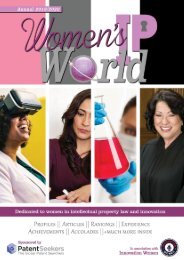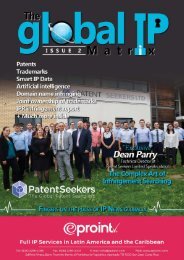Global IP Matrix - Issue 7
Dear readers, We sincerely hope that you are all in good health and keeping in good spirits during these undeniably uncertain times. We have all had to adapt to working out of our comfort zones, which I am sure has been very challenging at times for you all as it has been for us. However, we continue our quest to look to the future and deliver exclusive content to you, direct from thought leaders working at ground level in the IP industry from all over the world. Issue 7 of The Global IP Matrix magazine is packed with informative and exciting articles to keep you up to date and educated in what has been developing in the global IP industry during the past few months and into the future. We hope you enjoy reading our publication. We want to thank all our contributors for sharing their knowledge, opinions, and expertise in this new edition of the Global IP Matrix magazine. From all of us at The Global IP Matrix & Northon's Media, PR & Marketing Ltd
Dear readers,
We sincerely hope that you are all in good health and keeping in good spirits during these undeniably uncertain times. We have all had to adapt to working out of our comfort zones, which I am sure has been very challenging at times for you all as it has been for us.
However, we continue our quest to look to the future and deliver exclusive content to you, direct from thought leaders working at ground level in the IP industry from all over the world.
Issue 7 of The Global IP Matrix magazine is packed with informative and exciting articles to keep you up to date and educated in what has been developing in the global IP industry during the past few months and into the future. We hope you enjoy reading our publication.
We want to thank all our contributors for sharing their knowledge, opinions, and expertise in this new edition of the Global IP Matrix magazine.
From all of us at The Global IP Matrix & Northon's Media, PR & Marketing Ltd
You also want an ePaper? Increase the reach of your titles
YUMPU automatically turns print PDFs into web optimized ePapers that Google loves.
Interpretation of Contents on Intellectual
Property of the First Phase of Economic
and Trade Agreement between
China and the United States
On January 15, China and the
United States signed the First Phase
of Economic and Trade Agreement.
The agreement is good news for
China, America, and the entire
world. This agreement includes nine
chapters: the preamble, intellectual
property, technology transfer,
food and agricultural products,
financial services, exchange rates,
transparency, expanded trade,
bilateral assessments, and dispute
settlement. At the same time, the two
sides agreed that the United States
would fulfill its commitment to phase
out tariffs on Chinese products and
realise the transition from raising
tariffs to lowering tariffs.
Written by Lei Zhao Partner/Attorney at Law at Unitalen
www.unitalen.com
From the perspective of content distribution,
the intellectual property part is located in the
first chapter of the agreement, which fully
reflects the importance both countries attach
to intellectual property protection. Intellectual
property, whether in the formulation of laws
and regulations or judicial system reform
and other aspects, has played a leading role in
China. It is also one of the most intense focuses
of economic and trade negotiations between
countries, especially China and the United
States.
The intellectual property part of the China-
US economic and trade agreement includes
the contents that have been already adopted
by Chinese laws and regulations as well as
various reviews and trial guidelines in the past
two years, such as the application of punitive
damages, curbing malicious registration, and
conditional transfer of the burden of proof. It
also includes the new, even need to make an
important change in reviews and enforcement
practice at the present stage, such as the
extension of the validity of a patent, reduce
the transfer of criminal investigation in the
administrative law enforcement standard,
and the establishment of the rapid judgment
enforcement system.
I. Improving the protection of
trade secrets
According to article 1.3 and article 1.4 and
article 1.5 of the agreement, all natural
persons and legal persons can be liable for
the infringement of trade secret law and
infringement of trade secret. They should
be held accountable to prohibit behaviour
in a way that completely covers the theft of
trade secrets. Moreover, in the civil judicial
procedure, the burden of proof or evidence
could be discretionarily transferred to the
defendant. The above contents were reflected
in the newly revised anti-unfair competition
law in 2019.
In addition, article 1.7 of the agreement
also involves “lowering the threshold for
the initiation of criminal law enforcement,
and eliminating any content that takes the
determination of actual loss by the holder
of business secrets as a prerequisite for the
initiation of a criminal investigation on the
infringement of business secrets”.
Ii. Highlight the protection of
intellectual property rights of
pharmaceuticals
In regard to patent protection, section 3 of
chapter I of the agreement specifically provides
for the effective protection and enforcement
of drug-related intellectual property rights,
“including patents and undisclosed test
data or other data submitted to meet the
requirements for market approval”. Specific
measures proposed in articles 1.10 and 1.11
include allowing “supplementary data to meet
relevant patentability requirements” establish
“effective mechanisms for early resolution of
patent disputes”. In addition, in article 1.12 of
the agreement, it is proposed to “extend the
duration of the patent to compensate for the
unreasonable delay in the patent authorisation
or drug marketing approval process”. For
patents on new drug products approved for
market in China and on the methods for their
manufacture and use, the extension period
may be limited to a maximum of five years,
and the total period of validity of the patent
shall not exceed 14 years from the date of
approval for the market in China.
Relevant provisions on extending the duration
of patent protection for innovative drugs have
also been presented in the 2019 amendment to
the patent law (draft).
III. Combating piracy and
counterfeiting
Sections v and vii of chapter I of the agreement
emphasise the need to combat piracy and
counterfeiting; there are two targets, namely
online infringement (including piracy and
counterfeiting on e-commerce platforms) and
product infringement related to public health
or personal safety.
In terms of dealing with Internet infringement,
article 1.13 (1) of the agreement proposes to
establish an effective notification and removal
system to enable IP owners to take effective
and prompt actions against the infringement
in the Internet environment. In addition, the
article 1.14 of the agreement, “for failing
to take the necessary measures to control
the infringement of intellectual property
rights main e-commerce platform, should
take effective action to combat platform of
counterfeit or pirated goods”, and by way of
business licenses revoked network punishment
“repeatedly failed to curb counterfeit or
pirated goods sales e-commerce platform”.
To some extent, this imposes an obligation
on the major e-commerce platforms to take
necessary measures to rectify the infringement
of intellectual property rights.
From the perspective of the harmfulness of
piracy and counterfeit products themselves,
counterfeit goods with health and safety
risks will have a significant impact on public
health or personal safety, so we should focus
on cracking down on these products that
affect the national economy and people’s
livelihood. Article 1.20 of the agreement
provides for the destruction of counterfeit
goods in terms of border measures, civil and
criminal justice procedures and, in addition to
the destruction of the goods themselves, “shall
order the immediate destruction, without
compensation, of materials and tools primarily
used in the production or manufacture of
counterfeit or pirated goods”.
Iv. Cracking down on malicious
trademark registration
Article 1.24 of the agreement states that “in
order to strengthen trademark protection,
both parties shall ensure the full and effective
protection and enforcement of trademark
rights, especially to combat malicious
trademark registration”. Previously, the
newly revised Trademark Law in 2019 had
made adjustments in two aspects: regulating
malicious applications, hoarding registration,
and increasing penalties for trademark
infringement. Revised trademark law in
response to the malicious registered enhanced
obligations on the use of trademarks, article
4 of the specified “malicious trademark
applications without intent to use shall
be rejected”, and the malicious registered,
malicious litigation rules on the punishment
measures in article 68 specifically warning or
fines;
In order to further implement the latest
provisions of the Trademark Law, the State
Administration for Market Supervision
and Regulation issued several provisions
on standardising trademark application for
registration on October 10, 2019. It lists the
factors to be considered in the examination
of a malicious application for trademark
registration to enhance the operability
and transparency of the examination of
trademark registration. And through the
penalty such as fines and other ways against
the malicious trademark applicants and
trademark agencies, China is severely cracking
down on malicious trademark applications
and illegal agency behaviour.
V. Strengthening judicial
protection of intellectual
property rights
Section 9 of chapter I of the agreement
proposes that the transfer procedure from
administrative law enforcement to criminal
law enforcement should be improved. Article
1.26 proposes that “if according to objective
criteria, there is a ‘reasonable doubt’ based
on clear facts about criminal violations of
intellectual property rights, the administrative
department shall be required to transfer the
case to criminal law enforcement”.
Article 1.27 of the agreement also calls for
greater civil relief and criminal penalties for
intellectual property theft or infringement.
Specifically: “as transitional measures, possible
theft or infringement of intellectual property
should be contained, and the application
of existing remedies and penalties shall be
strengthened. To deter possible theft or
infringement of intellectual property rights
by imposing heavier penalties in a manner
close to or up to the maximum legal penalty
in accordance with the relevant laws on
intellectual property rights. As a followup,
statutory minimum and maximum
compensation, prison sentences, and fines
should be increased to deter future theft or
infringement of intellectual property.
Epilogue
Strengthening the protection of intellectual
property rights is a common goal of China
and the United States. The above-mentioned
consensus reached by the two sides in
the agreement protects the interests of
both sides. It conforms to China’s reform
direction of strengthening the protection of
intellectual property rights. It is not difficult
to find that China’s intellectual property
system has been gradually improved and
developed, which also reflects the content of
intellectual property protection proposed in
the agreement.
As the Vice-Minister of Commerce and
International Trade Negotiations, Deputy
Representative, Wang Shouwen puts it, “the
implementation of the relevant details,
will help to strengthen the protection of
intellectual property rights, improve the
business environment, expanding market
access, and better maintenance of all kinds
of enterprise in China, including foreign
enterprises, legitimate rights, and interests,
but also to protect Chinese enterprises and
the lawful rights and interests in economic
and trade activities to the U.S”.
16 www.gipmatrix.com www.gipmatrix.com
17












